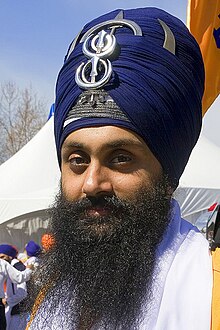Dumalla
This articleneeds additional citations forverification.(May 2015) |

| Part ofa serieson |
| Sikhism |
|---|
 |
TheDumallais a type of turban worn bySikhs.This turban is worn mainly by Sikhs who are initiated into theKhalsa,through participating in theAmrit Sancharbut can be worn by all Sikhs. However, the more common one is theDastar.The word Dumalla means "Du" meaning two and "Malla" meaning cloth or fabric. This is because there will usually be one fabric to form the base of the turban and a second to wrap around the base to form the turban itself. There many different types of Dumalla, in many different sizes and colours.
Symbolism
[edit]The Dumalla style may trace its origin toFateh Singh,the youngest son ofGuru Gobind Singh.[1][2]The Dumalla itself was worn by many of the SikhGurus,thus many Sikhs also adopted the Dumalla. During the era ofMughalrule many Mughals would wear turbans as a crown to show they were of royal stature and was seen as a symbol of noble authority, whereas the poor and those who were notMuslimwere not allowed to wear turbans, leading to oppression and inequality during the rule. Sikh Gurus, most notably starting withGuru Arjan Dev,seeing this took a stand against this and said "If the Mughals wear one turban, we will wear two" to show that they would stand against the oppression and tyranny of that age. Since then, Sikhs have been wearing the Dumalla as part of practicing their way of life.
Styles
[edit]Modern Dumalla
[edit]This is the turban many Sikhs who wear the Dumalla will adorn. There will usually be a base made with the hair wrapped into a bun through being twisted into a cloth to form the base or forming a bun and then covering with a cloth. It is generally tied in the way that the first layer goes over the right ear to the left top side of the base in a diagonal wrap and the same follows with the over the left ear to the right top side of the base and the third wrap going from the right ear to the top in a horizontal wrap across the top of the eyebrows. The rest of the turban is tied following the same pattern as the third wrap, being wrapped above each additional wrap until it reaches the top of turban and the extra cloth is tucked in between the existing wraps.
Chand Tora
[edit]This is awarriorstyle turban which was worn by Sikhs in battle. The "Chand" is a metal symbol consisting of a crescent sword and a double edged sword, it is held in place at the front of the turban by the "Tora" which is wovenchainmailcord tied in a pattern within the turban to protect the head from slashing weapons. This type of turban is generally worn byNihangSinghs.
Gol
[edit]"Gol" means round and so this is the round dumalla, frequently called the "gol dastaar". This can also be tied with a base but instead of diagonal wraps, this turban is tied going around the head with each wrap going above the last. This is generally the simplest type of dumalla to tie and was popularised mainly by the leaders ofDamdami Taksaal,the walking university of Sikhism such asJarnail Singhand Sant Kartar Singh. Also as well as manyNanaksar.
See also
[edit]References
[edit]- ^Singh, Pashaura; Fenech, Louis E. (March 2014)."Taksals, Akharas, and Nihang Deras".The Oxford Handbook of Sikh Studies.Oxford Handbooks, OUP Oxford, 2014. p. 378.ISBN9780191004117.
- ^Singh, Nirdr (1998).The Fighting Traditions and Fighting Arts of the Traditional Sikh Warriors the Beloved of Guru Gobind Singh Ji the Akali Nihangs(2nd ed.). Budha Dal and Tarna Dal.
